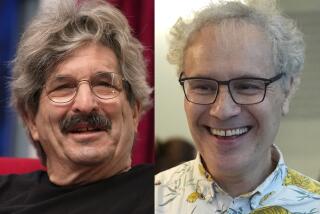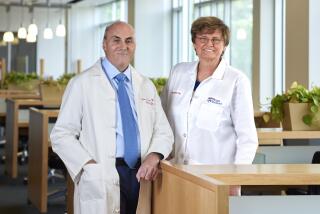Frederick Sanger dies at 95; biochemist revolutionized DNA sequencing
DNA and proteins are arguably the most important components of the cells of living creatures. Both are produced by stringing together long chains of individual molecules — amino acids in the case of proteins and nucleotides in DNA.
Understanding the identity of the individual molecules in these chains and the sequence in which they are strung together proved to be one of the major biological challenges of the last century. Only by unlocking these sequences would scientists be able not only to understand the fundamental workings of biochemistry, but also to duplicate it.
In the early 1950s, British biochemist Frederick Sanger of Cambridge University developed the first viable technique for determining the amino acid sequence of proteins and used it to describe the structure of insulin, which is composed of 51 amino acids. His work led to the first precise identification of the composition and structure of a protein and proved that such structures are unique.
In honor of that work, Sanger received the 1958 Nobel Prize in Chemistry.
After a move to the Medical Research Council Laboratory of Molecular Biology, Sanger turned his attention to the much more difficult problem of sequencing DNA. By 1977, he and his colleagues were able to establish the sequence of the 5,386 nucleotides in the virus phiX174.
Using a refinement of this technique, in 1981 they established the sequence of human mitochondrial DNA, which is composed of 16,569 pairs of nucleotides — the first human DNA ever sequenced. The following year, they published the sequence of bacteriophage lambda, which has 48,502 base pairs. The technology they used has subsequently been automated and used in sequencing the 3 billion base pairs of the human genome.
For developing this DNA sequencing method, Sanger shared the 1980 Nobel Prize in Chemistry, making him the first person to win two chemistry Nobels, the first Briton to win two Nobels, and only the fourth researcher ever to win two.
Sanger died Tuesday at Addenbrooke’s Hospital in Cambridge, near his home in the nearby village of Swaffham Bulbeck. He was 95.
In a statement announcing Sanger’s death, Jeremy Farrar, director of the Wellcome Trust, which funded much of Sanger’s work, said, “Fred can fairly be called the father of the genomic era: His work laid the foundations of humanity’s ability to read and understand the genetic code, which has revolutionized biology and is today contributing to transformative improvements in healthcare.”
In a separate statement, Venki Ramakrishnan, deputy director of the Laboratory of Molecular Biology, said that “Fred is one of the outstanding scientists of the last century, and it is simply impossible to overestimate the impact he has had on modern genetics and molecular biology.”
Frederick Sanger was born Aug. 13, 1918, in Rendcomb, Gloucestershire, England. His father was a physician and his mother was the heiress of a prosperous cotton manufacturer, which allowed young Sanger to be financially independent through most of his collegiate studies.
He enrolled in St. John’s College at Cambridge, intending to follow in his father’s footsteps as a physician. He later wrote that he was “not academically brilliant,” and that only his parents’ wealth allowed him to attend Cambridge. But once he discovered the sciences and, in particular, laboratory experimentation, he found that he could “hold my own even with the most academically outstanding.”
He received his bachelor’s degree in natural sciences in 1939, just as the war in Europe was beginning. His Quaker religion made him a conscientious objector and he was excused from service and allowed to continue his doctoral research, receiving his degree in 1943.
Continuing to work at Cambridge, he began to explore ways to determine the structure of proteins. Proteins were too large for researchers to simply determine their sequence in a straightforward manner. Working with insulin, which was one of the few proteins then available in a pure form, Sanger developed the idea of breaking it down into smaller peptides, which could be separated and analyzed individually.
A key to this process was Sanger’s discovery of a chemical called dinitrophenol, or DNP, which bound strongly to only one end of a protein or peptide chain. Using this reagent, Sanger could analyze each peptide one amino acid at a time, working from one end.
When the original protein was broken apart under varying conditions, the technique produced peptides of different lengths. Overlaps in sequences in peptides produced under different conditions allowed the complete protein to be reassembled much like a jigsaw puzzle.
Unlike most researchers who win a Nobel, Sanger did not use his first prize as an opportunity to become an administrator or to set up a large lab where he could assign research projects to underlings. He later wrote that he had little talent for either teaching or administration and was not good at creating experiments for others. What he liked to do, he said, was research.
Sanger applied a similar approach to DNA analysis, but this time he used enzymes to copy a single-stranded piece of DNA, stopping the process at various points to determine the nucleotide at the end of the growing chain. Advances in chemistry by this time allowed analysis of nucleotide chain fragments containing as many as 800 nucleotides.
Walter Gilbert of Harvard University had independently developed a technique for sequencing DNA, and he and Sanger shared the 1980 Nobel with Paul Berg of Stanford, who was the first to move a gene from one organism to another. Sanger’s approach proved much more efficient than Gilbert’s, however, and it is now widely used.
The only other researchers to receive two Nobels were John Bardeen, who received the physics prize in 1956 and 1972; Marie Curie, who received the physics Nobel in 1903 and the chemistry Nobel in 1911; and Linus Pauling, who received the chemistry Nobel in 1954 and the Nobel Peace Prize in 1962.
Sanger retired at the age of 65 to spend more time gardening and “messing about in boats.”
He received Britain’s Order of Merit in 1986, but refused a knighthood, saying that he did not want to be called “Sir.”
Sanger was preceded in death by his wife, the former Margaret Joan Howe. He is survived by two sons, Robin and Peter, and a daughter, Sally Joan.
More to Read
Start your day right
Sign up for Essential California for the L.A. Times biggest news, features and recommendations in your inbox six days a week.
You may occasionally receive promotional content from the Los Angeles Times.






